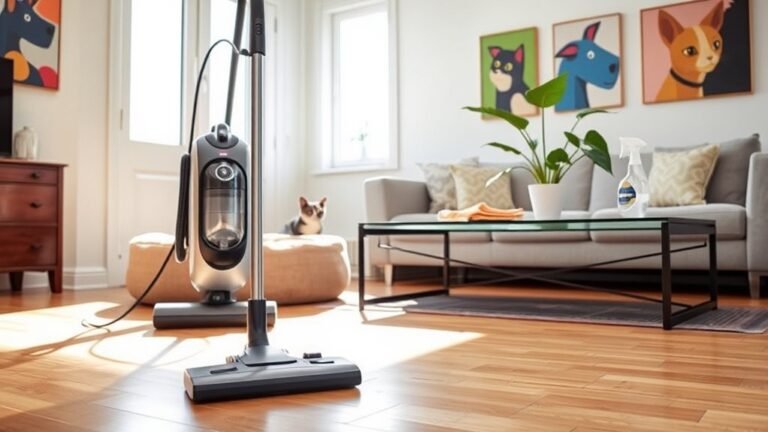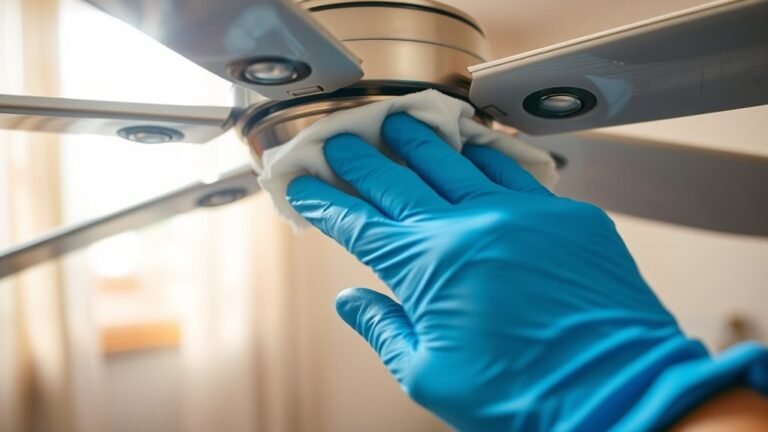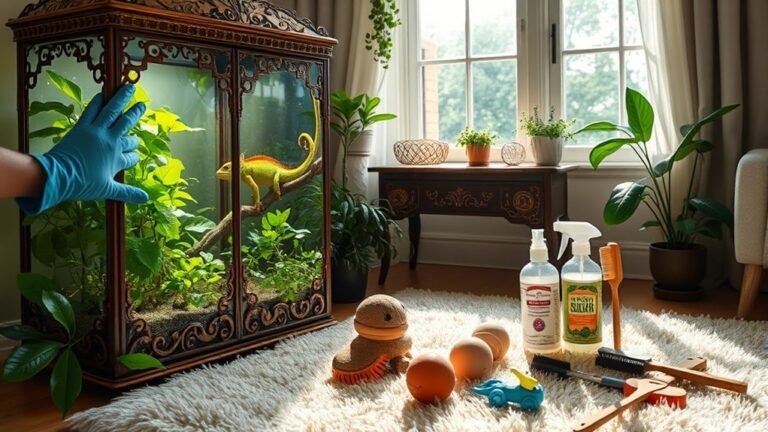Top 10 Tips for Cleaning Toys
To keep your child’s toys clean and safe, use the right method for each type—wipe plastic, gently wash wood, and machine wash soft toys when allowed. Choose non-toxic cleaners like mild soap or vinegar. Wipe hard toys weekly, clean outdoor toys more often, and carefully disinfect battery-operated ones after removing batteries. Treat stains naturally with baking soda or lemon juice, and always dry toys completely to prevent mold. Setting a cleaning routine helps maintain hygiene and playtime fun. Keep exploring for detailed tips and tricks.
Choose the Right Cleaning Method for Each Toy
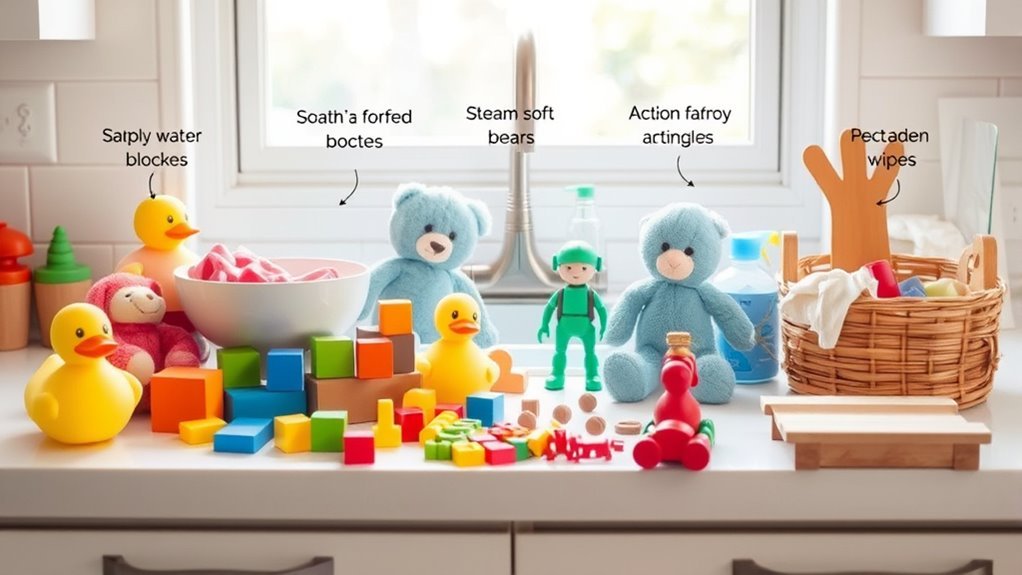
When cleaning toys, it’s important to pick the right method for each type to avoid damage. Different toy material types—like plastic, fabric, or wood—need specific care. For example, plastic toys can often be wiped with a damp cloth or washed in warm soapy water, but wooden toys require gentler cleaning to prevent warping. Fabric toys might need spot cleaning or occasional machine washing, depending on the label. Following cleaning frequency guidelines helps keep toys safe and fresh without overdoing it; hard toys might need weekly cleaning, while soft toys could be cleaned less often unless visibly dirty. By matching your cleaning approach to each toy’s material and sticking to sensible schedules, you maintain their quality and your freedom from unnecessary hassle.
Use Safe and Non-Toxic Cleaning Products
When cleaning your child’s toys, it’s important to choose products with child-friendly ingredients. You’ll want to avoid harsh chemicals that could irritate their skin or cause harm. Sticking to safe, non-toxic options keeps playtime both fun and healthy.
Choose Child-Friendly Ingredients
Although you might be tempted to use strong cleaners for quick results, choosing child-friendly, non-toxic ingredients is essential for keeping your child’s toys safe. Opting for natural cleaners and safe alternatives lets you clean effectively without exposing your little one to harmful substances. Here are some kid-safe options to take into account:
- Mild dish soap mixed with warm water
- White vinegar diluted with water
- Baking soda paste for scrubbing tough spots
- Lemon juice as a natural disinfectant
- Castile soap, a gentle plant-based cleaner
These ingredients not only protect your child’s health but also give you the freedom to clean confidently. Stick to these natural cleaners for a safe, effective, and eco-friendly toy-cleaning routine that keeps playtime worry-free.
Avoid Harsh Chemicals
Since your child’s safety comes first, steering clear of harsh chemicals is essential when cleaning toys. Those strong cleaners might seem effective, but they often carry chemical hazards that can harm your little one’s health. Instead, opt for natural alternatives like vinegar, baking soda, or gentle castile soap. These options clean thoroughly without exposing your child to toxins. You’ll feel freer knowing you’re using safe, non-toxic products that protect your family and the environment. Avoid bleach or ammonia-based cleaners, which can leave harmful residues. Choosing natural alternatives not only keeps your toys spotless but also gives you peace of mind. Remember, a clean toy doesn’t have to come at the cost of your child’s well-being or your freedom to choose safer solutions.
Regularly Wipe Down Hard Plastic Toys
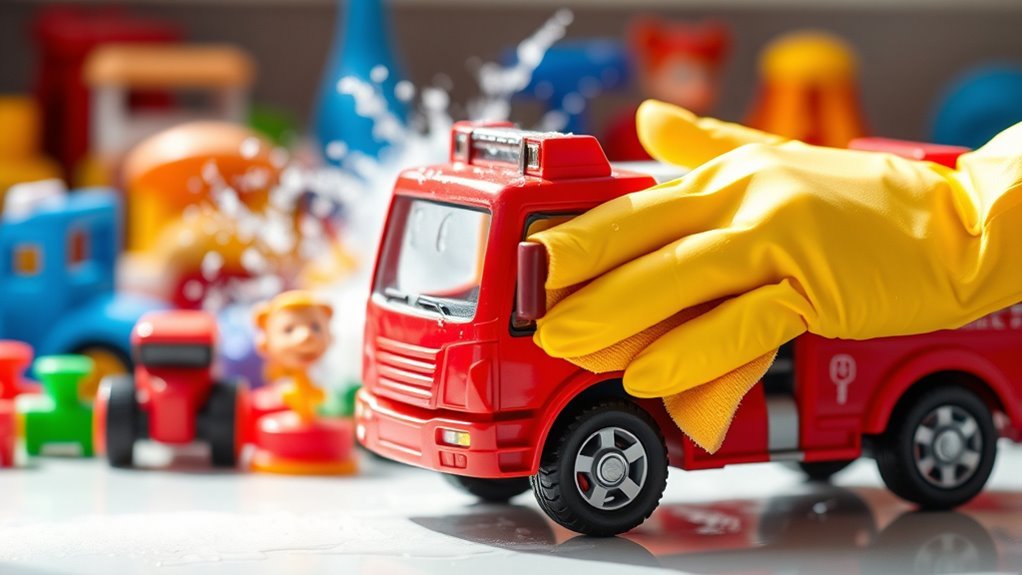
Regularly wiping down hard plastic toys helps keep germs at bay and extends their lifespan. Sticking to simple toy hygiene practices means you can keep playtime safe and fun without fuss. Here are some effective cleaning techniques you can easily do yourself:
Regularly wiping plastic toys keeps germs away and playtime safe with simple, fuss-free cleaning techniques.
- Use a damp cloth with mild soap to wipe surfaces.
- Avoid harsh chemicals that can damage plastic or harm kids.
- Focus on crevices where dirt and germs hide.
- Rinse with warm water and dry thoroughly to prevent mold.
- Schedule regular cleanings, especially after outdoor play.
Wash Soft Toys in the Washing Machine
When washing soft toys in the machine, you’ll want to select the gentle cycle to protect their fabric and stuffing. Make sure to use a mild detergent that’s safe for delicate materials. This way, your child’s favorite plush will come out clean without any damage.
Choose Gentle Cycle
Although it might be tempting to use a quick wash, choosing the gentle cycle is crucial for cleaning soft toys in your washing machine. This setting helps protect their fabric and stuffing while still getting them fresh and clean. To make the most of this washing tip, keep these pointers in mind:
- Use cold or lukewarm water to prevent colors from fading.
- Avoid high spin speeds to reduce wear and tear.
- Place toys inside a mesh laundry bag to protect seams.
- Skip heavy loads to guarantee gentle tumbling.
- Check manufacturer labels for cycle recommendations.
Use Mild Detergent
Since harsh chemicals can damage soft toys, you’ll want to use a mild detergent when washing them in the machine. Mild detergent benefits include protecting delicate fabrics while effectively cleaning dirt and germs. Choosing an eco friendly option not only safeguards your child’s favorite toys but also reduces environmental impact, giving you peace of mind. These detergents are free from aggressive chemicals and fragrances, which helps prevent skin irritation and preserves the toy’s texture and color. When selecting your detergent, look for labels that specify gentle formulas or are designed for baby clothes—both great indicators of suitability for soft toys. Using mild detergent guarantees your toys stay fresh and safe without compromising your values or your freedom to care for your family responsibly.
Disinfect Electronic and Battery-Operated Toys Carefully

Because electronic and battery-operated toys can’t be soaked or wiped with harsh chemicals, you need to clean them with extra care to avoid damage. Prioritize battery safety and electronic maintenance to keep toys working and safe. Here’s how you can do it:
- Remove batteries before cleaning to prevent leaks or shorts.
- Use a soft cloth dampened with a mild disinfectant solution.
- Avoid spraying liquids directly on toys; instead, apply to the cloth.
- Gently wipe surfaces, focusing on buttons and handles.
- Let toys air dry completely before reinserting batteries.
These simple steps help you maintain your child’s favorite gadgets without risking electrical damage or cutting short their fun. You get to enjoy peace of mind knowing your toys are clean, safe, and ready for play.
Utilize Dishwasher Cleaning for Durable Toys
If your toys are made from dishwasher-safe materials like hard plastic, you can save time by cleaning them in the dishwasher. Just make sure to use gentle settings to avoid warping or damage. Always check the manufacturer’s guidelines before tossing toys in the dishwasher.
Dishwasher Safe Toy Materials
When you want to quickly clean toys without much hassle, choosing dishwasher-safe materials can be a game changer. You’ll save time and avoid scrubbing every nook and cranny manually. Durable toys like silicone toys and plastic figurines are great candidates for dishwasher cleaning. Here are some common dishwasher-safe toy materials to look for:
- Silicone toys: flexible, heat-resistant, and easy to sanitize
- Hard plastic figurines: sturdy and won’t warp under dishwasher heat
- Stainless steel toys: rust-resistant and dishwasher-friendly
- BPA-free polypropylene toys: durable and dishwasher safe
- Rubber toys labeled as dishwasher safe: withstand heat without damage
Proper Dishwasher Settings
Although dishwasher-safe toys can handle the heat and water, you’ll want to choose the right settings to keep them in top shape. Proper dishwasher temperature settings prevent warping or fading, while smart dishwasher loading techniques guarantee thorough cleaning without damage. Here’s a quick guide:
| Setting Type | Recommended Temp | Loading Tips |
|---|---|---|
| Gentle/Delicate | 110°F – 120°F (43°C-49°C) | Place toys securely on top rack |
| Normal | 120°F – 140°F (49°C-60°C) | Avoid overcrowding for water flow |
| Heavy Duty | 140°F – 160°F (60°C-71°C) | Use only for very durable toys |
Stick with gentle or normal cycles for most toys, load them carefully, and let your dishwasher freedom shine without worry!
Clean Outdoor Toys More Frequently
Since outdoor toys are exposed to dirt, pollen, and germs more often, you should clean them more frequently to keep your kids safe and healthy. Regular outdoor cleaning not only protects your children but also extends toy maintenance, helping toys last longer. Here’s how to stay on top of it:
- Rinse toys with a garden hose after each use to remove loose dirt.
- Use mild soap and warm water weekly for a deeper clean.
- Disinfect plastic toys with a diluted bleach solution occasionally.
- Inspect toys for damage regularly and repair or discard as needed.
- Store toys in a dry, shaded area to minimize mildew and sun damage.
Remove Stains With Natural Cleaning Solutions
Keeping outdoor toys clean is just part of the job—you’ll also want to tackle stains using natural cleaning solutions that are safe for kids and the environment. You can whip up effective stain removal mixtures using natural ingredients like baking soda, white vinegar, and lemon juice. For tough stains, make a paste with baking soda and water, apply it to the spot, and let it sit for 10 minutes before rinsing. A spray of diluted white vinegar can also lift dirt without harsh chemicals. These natural solutions not only remove stains but also let you clean toys without worrying about toxins or residues. Embracing these simple, eco-friendly methods gives you freedom from synthetic cleaners while keeping your child’s playthings bright and safe.
Dry Toys Thoroughly to Prevent Mold
If you don’t dry toys thoroughly after washing, mold can quickly develop, posing health risks for your child. Proper drying techniques are essential for mold prevention and keeping toys safe. Here’s how you can guarantee toys dry completely:
- Air dry toys in a well-ventilated area to speed up moisture evaporation.
- Use a clean towel to wipe off excess water immediately after washing.
- Avoid stacking toys while wet to prevent trapped moisture.
- For fabric toys, consider using a fan or placing them in sunlight.
- Regularly check for damp spots or musty odors that signal hidden mold.
Establish a Toy Cleaning Schedule
Although cleaning toys may seem like a chore, establishing a regular cleaning schedule makes the task manageable and guarantees your child’s playthings stay safe and hygienic. Start by setting a cleaning frequency that fits your lifestyle—weekly, biweekly, or monthly. Pair this with a toy rotation system to reduce the number of toys in use at once, making cleaning quicker and more efficient. Rotating toys also keeps playtime fresh, giving your child variety while you maintain control over cleanliness. Stick to your schedule without overcomplicating it; consistency is key. By doing this, you’ll free yourself from last-minute scrambles to sanitize toys and enjoy peace of mind knowing your kid’s environment is healthier and more organized.
Frequently Asked Questions
How Often Should Toys Be Replaced Instead of Cleaned?
Did you know that the average toy lifespan is about three years before it becomes unsafe or too worn out? When thinking about replacement frequency, you’ll want to swap out toys that show cracks, broken parts, or persistent stains you can’t clean. This keeps playtime safe and fun without feeling tied down. Trust your instincts—if a toy feels beyond repair, it’s time to let it go and refresh the collection.
Can Cleaning Toys Too Often Damage Them?
You might wonder if cleaning toys too often can cause damage. It really depends on the toy material durability; some materials like soft plastics or fabric might wear down faster with frequent washing. Cleaning frequency impact is real—overdoing it can lead to fading, weakening, or even breaking parts. So, you want to balance keeping toys clean while preserving their lifespan, letting you enjoy them freely without worry.
Are There Any Toys That Should Never Be Cleaned?
Think of some toys as fragile castles built from delicate materials—too much water or scrubbing can crumble their walls. You’ll want to avoid cleaning toys with battery safety concerns too; water can short-circuit their tiny power sources and leave them lifeless. So, if a toy’s made from soft fabrics or contains electronic parts, you’re better off giving it a gentle wipe or spot clean, preserving its freedom to bring joy without damage.
How to Clean Toys With Small Electronic Components Inside?
When cleaning toys with small electronic components, you need to take safety precautions seriously. Don’t submerge them in water; instead, use a damp cloth with mild soap to gently wipe the surface. Avoid harsh chemicals that could damage the electronics. If possible, remove batteries beforehand to prevent short circuits. Let the toy air dry completely before reassembling. These cleaning techniques help keep your toys safe and functional without restricting your freedom to enjoy them.
What Are the Best Storage Tips to Keep Toys Clean?
You’ll want to explore smart storage solutions that keep toys tidy and clean while giving you freedom to access them easily. Clear bins or labeled containers help with quick organization strategies, so toys don’t get lost or dirty. Using shelves or stackable boxes maximizes space and reduces clutter. Keeping toys off the floor prevents dust buildup, letting you enjoy a cleaner, more organized environment without feeling trapped by mess.


